Do you want to increase your website traffic?
Who doesn’t?
Over the years, I have seen a lot of websites driving tons of additional traffic to their content with the right SEO plan.
I’ve also seen other websites struggling to drive traffic while wondering what they did wrong.
In this article, I will share some successful SEO case studies with you and explain how having the right SEO approach can make a big impact in driving organic traffic.
Note: This is a guest post by Benjamin Rojas, the president of All in One SEO, the best WordPress SEO plugin on the market. This is an expert column that we publish every other Thursday, where we invite a WordPress expert to share their experiences with our readers.

I will cover quite a few topics in this post. Here’s a handy list so you can jump to the section you are most interested in:
Video Tutorial
If you’d prefer the written version, keep reading.
1. Lay a Solid SEO Foundation
SEO is not complex. It is comprehensive. You need to keep SEO in mind even when you start building your site.
Unfortunately, many businesses think of SEO as a patchwork on top of whatever they are already doing.
By building a solid foundation with a clear-cut SEO strategy, we’ve seen several new websites grow their organic traffic exponentially.
Let’s take a look at Sporked.com, a food review website that grew traffic by 1,036% YoY, for example.
This website built a solid SEO foundation by applying Google’s E-E-A-T (Experience, Expertise, Authority, and Trustworthiness) principles from the very beginning.
Here is how their website’s traffic exploded.

Sporked is a very focused niche website. Google loves niche websites as it is easier for those sites to demonstrate their E-E-A-T.
The solid SEO foundation alone wasn’t the only reason for Sporked’s traffic growth. High-quality content, consistency, and backlinks also gave them an SEO boost.
Here is what you need to do to ensure that you are building an SEO-friendly business from the start.
1. Equip Yourself with the Right SEO Tools
Make sure you have the tools that help you easily implement SEO recommendations on your site. Below are a few:
- A WordPress SEO plugin: An SEO plugin like All in One SEO (AIOSEO) makes it easy to optimize your site for search engines, even if you’re an absolute newbie.
- Google Search Console: It helps you identify how your site performs on Google for free.
- Google Analytics: It gives you insights into how every website visitor interacts with your site. Using a plugin like MonsterInsights is the easiest way to install Google Analytics on your site.
- A professional SEO tool: With an SEO tool like Semrush, you can analyze competitor content and make informed decisions to boost rankings.
2. Configure Essential SEO Settings
There are some essential SEO settings you’ll need to enable on your site.
These include your permalink structure, categories and tags, and WordPress sitemaps.
I highly recommend checking out the essential WordPress site settings that are critical for SEO success.
For more details, check out the ultimate WordPress SEO guide for beginners.
2. Don’t Forget About Keyword Research
Keywords are the search terms that users type into Google and other search engines to find information. Understanding which keywords your users may be looking for gives you a tremendous advantage in optimizing your website.
This means that you will want to focus on keyword research.
Ideally, you will want to rank for keywords that have the most search volume. However, those keywords may be difficult to rank for, especially for a new website.
In my experience, targeting keywords with the right balance of search volume and lower difficulty level helps you gain the traffic boost you need at the start.
Here’s how Content Authority, a content services provider, uses Keyword Research to grow its traffic by almost 300%.
Content Authority is a content services provider. They grew their website traffic by almost 300%, mainly due to the clever use of keyword research in their strategy.
They are in a highly competitive industry of content creation. Most of their competitors are equally good at creating high-quality content and the latest SEO trends.
To stand out among the competition and capture an untapped traffic source, Content Authority targeted misspelled keywords. They wrote articles targeting those keywords in articles like:
- Cruncy vs Crunchy: Decoding Common Word Mix-Ups
- Excel Vs. Accel: What’s The Correct Spelling Of This Word?
- Adress Vs. Address: What’s The Correct Spelling Of This Word?
Did it work? Yes, it did. Most of their top-ranked content is in this format, targeting misspelled words.

Why did it work? Content Authority writes exclusively about creating content and writing. Writing articles about correct spelling usage falls right into their area of expertise.
Lesson learned: In a competitive industry, clever keyword research can help you bring traffic from untapped sources that your competitors may have ignored entirely.
Here’s how you can implement the same strategy on your site.
1. Understand the Keywords Your Website Ranks For
Google Search Console is a handy tool that helps you identify the keywords your website ranks for. If you want, you can also use an SEO plugin like AIOSEO that helps you view keyword data in your WordPress dashboard.
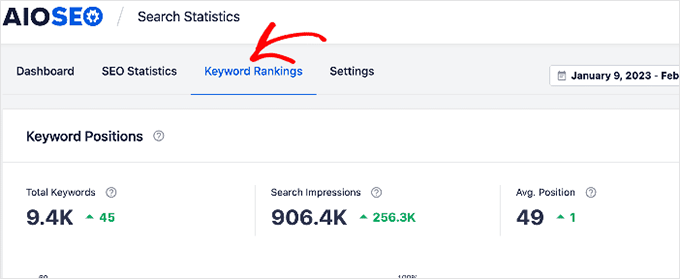
Here’s how to check if your blog posts are ranking for the right keywords.
2. Unveil More Keyword Insights
You can use a premium SEO tool like Semrush to clearly understand everything you need to know about a particular keyword. It offers detailed insights into search volume, keyword trends, similar keywords, user intent, and more.
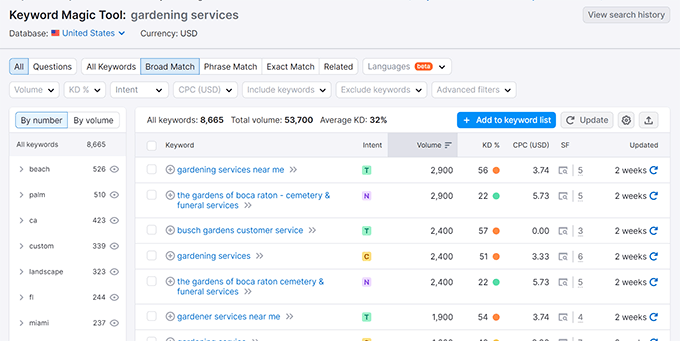
3. Generate Keyword Ideas
If you want to use a free tool to generate keyword ideas, you can use WPBeginner’s free Keyword Generator tool. Simply enter your main keyword, and the keyword generator tool will fetch hundreds of related keywords that people are using.

For more details, take a look at this guide on how to do keyword research.
3. Content is Still King
Many small businesses create a simple website with a few pages of content and hope for traffic to appear magically.
Unfortunately, it does not work that way anymore.
In fact, one of the best ways to drive traffic is to publish great content on a regular basis.
Let’s take a look at how Golfer Geeks, a website all about golf, grew its traffic by 190% through content marketing.
Golf is a highly competitive industry where websites are competing not just with other golf enthusiasts but big-name brands and media companies.
Golfer Geeks applied a very disciplined approach towards content. Each piece of content is highly structured, with multiple headings and sections, making it a pleasure to read.
They also use a proactive approach towards content decay. All their content gets regular updates with new information, keeping the content fresh and search engines happy.

They also actively used schema markup, particularly for FAQs.
This helped their content rank for many untapped keywords that their big-name brand competitors completely ignored.

Lesson learned: Excellent content, when combined with the latest SEO best practices, can help smaller websites compete with much larger publications.
If you want to grow your traffic by publishing content, as Golfer Geeks did, then here are a few things you need to take care of:
- Create a plan to regularly update all your blog articles on a regular basis to fight content decay. Learn more: What content decay is and how to fix it.
- Implement FAQ schema for People Also Ask results.
- Optimize images to increase the clickthrough rate on Google.
4. Using Schema Markup
Schema markup is a special type of HTML code that you can add to your WordPress website to tell search engines more about your content.
For instance, you can tell the search engines that a particular page is a blog post, a recipe, FAQs, a news article, or a product page in your online store. Search engines can then use this data to display rich results.

1. Implement Proper Schema Markup
Some types of content benefit more from schema markup than others. For instance, if you write product reviews, then adding the Review markup to your post will make it extremely useful for your users as well as search engines.
Learn how to properly add schema markup in WordPress and WooCommerce.
2. Create User-Centric Content
Schema markup gives you an advantage in search results, but this doesn’t mean that you need to start creating content for search engines alone.
Make sure that your schema markup actually helps users find the information they need. It supplements your actual content and makes it more discoverable.
Case Study: How a Food Blog Grew Traffic by 508%
For this part, I would like you to look at Iowa Girl Eats. It is a food blog specializing in gluten-free food.
It is an older blog that has been publishing content for a while, but recently, it has exploded in traffic.
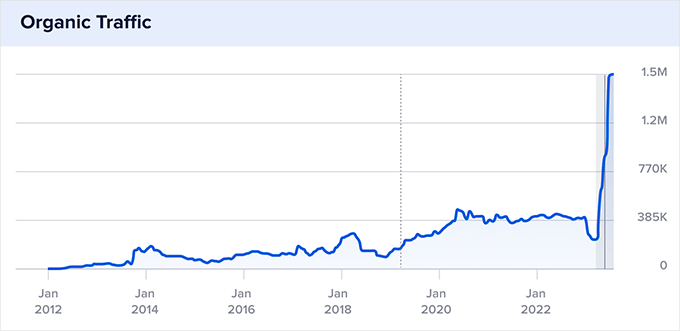
So what changed?
They started optimizing heavily for user-centric content using schema markup. The blog now ranks for 316.2K keywords with review schema markup.
After the success of the review snippets, the blog has now started focusing on recipe schema markup as well.
Lesson learned: Implement schema markup to make your content more user-centric and search engine-friendly.
5. The Power of Link Building
Links play a crucial role in SEO. Search engines treat links as authority signals. Generally speaking, the more links pointing towards a website, the more trustworthy that website becomes.
Now, there are two types of links you need to focus on:
- Internal links
- Backlinks from third-party domains
1. Building Internal Linking
Internal linking refers to the practice of linking to your existing content. This helps you achieve two things.
First, it lets your users discover more content when reading your articles.
Secondly, it helps search engines crawl more content and understand the context and subject authority of your website.
For more details, look at this internal linking guide for SEO.
2. Get Backlinks From Third-Party Sites
These backlinks are hard to get. Site owners try to avoid linking to external sources too much to ensure that more sites are pointing to their own domain names.
However, there are several ways to get backlinks. For instance, you can get reciprocal links from third parties by mentioning them on your website.
Reach out to other blogs in your industry that you believe you can partner with and pitch them your content.
3. Creating Link Magnets
Link magnets are the kind of posts that websites generally like to link to. These include:
- Industry research: This is one of the best backlink magnets, as every publisher looks for proof to validate a point they make in their content. Unique industry research does just that. As a result, people will link to it.
- Stats posts: Like industry research, statistics posts attract a lot of backlinks as they help validate content. Example: 60+ Affiliate Marketing Statistics You Need to Know.
- Case studies: Because they help readers see how a product or principle works in real life, case studies are another linkable asset you should create.
- Tools and cheat sheets: Creating resources that people can use to solve a problem is another excellent way of attracting backlinks. Example: WPBeginner’s Free Business Tools.
- Infographics: This content type is popular for presenting content simply and visually. Example: How WordPress Actually Works Behind the Scenes (Infographic)
These link magnets attract a lot of attention from other website owners in the industry and will help you gain a ton of backlinks.
Case Study: How Explore.com Quadrupled Their Traffic with Backlinks
Explore.com is a travel website, which is a highly competitive industry. This makes it difficult to remain at the top of search rankings.
Explore.com witnessed a very slow growth for 5 years straight, then they suddenly grew their traffic by 305%. What changed?
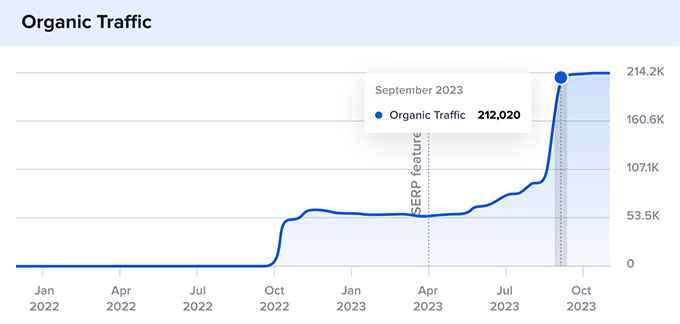
Looking closely, it’s clear that their traffic growth is directly proportional to an increase in backlinks.
Here is the graph.
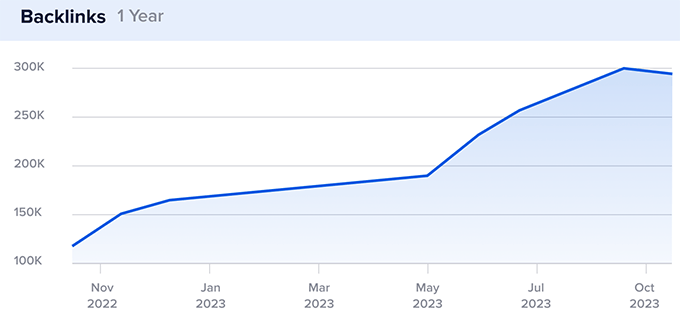
Obviously, backlinks alone were not the only reason for their organic growth.
They also implemented schema markup and started targeting a wide range of long-tail keywords that their competitors had ignored.
Lesson: Just a few backlinks from authoritative websites in your industry can have a huge impact on SERPs when combined with other SEO best practices.
6. Measure Your SEO Performance
One question that I have been asked a lot is, how do I measure SEO performance to see if something has worked or not?
As you apply SEO best practices and publish content regularly, you will want to see how they impact your website’s SEO.
Again, I’d recommend using all the SEO tools I mentioned in tip #1 of this article.
Case Study: How Meshki UK Grew Traffic by 589%
Meshki is a popular fashion brand in Australia, UK, and the US. They use country-based TLDs for their websites in each region.
This gives them a competitive advantage in local searches. But the real value they achieved is by adding review schema markup and monitoring branded keywords.
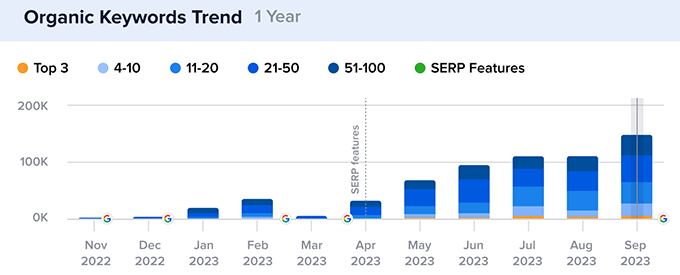
However, to get such a result, a website owner has to regularly monitor their SEO performance and measure the impact of changes they’re making.
Conclusion: Summary of Tips to Double Your SEO Traffic
These are just some of the ways that you can step up your SEO game and better compete with established brands.
Implementing all these tips might sound tedious, but you can take one lesson at a time and start testing them on your site.
To summarize, below are the tips we’ve explained so far:
- Lay a solid SEO foundation by using an excellent SEO plugin and using the right SEO settings.
- Keyword research can help small businesses compete with big-name brands and publishing companies.
- Publishing user-centric content is still the most important factor in winning organic traffic.
- Schema markup allows you to help search engines show rich results. In return, they send you more traffic and display your site more prominently.
- Focus on building both internal and third-party backlinks. Don’t underestimate the power of internal linking.
- Measure your SEO performance to view your gains and losses. Change strategies when needed or double down to have a much larger impact.
I hope these practical tips help you increase your SEO traffic. For further reading, I recommend following the WPBeginner SEO guide step by step.
If you liked this article, then please subscribe to our YouTube Channel for WordPress video tutorials. You can also find us on Twitter and Facebook.





Syed Balkhi says
Hey WPBeginner readers,
Did you know you can win exciting prizes by commenting on WPBeginner?
Every month, our top blog commenters will win HUGE rewards, including premium WordPress plugin licenses and cash prizes.
You can get more details about the contest from here.
Start sharing your thoughts below to stand a chance to win!
Jiří Vaněk says
SEO is the alpha and omega of my website, especially since I started using AIO SEO thanks to WPBeginner. This plugin has led me to deeply explore SEO techniques and practices to increase my website’s traffic, which I eventually succeeded in doing. Every piece of advice and practical experience in this field is absolutely invaluable. So, I want to thank Benjamin Rojas for sharing his know-how and valuable information. Thank you very much, Benjamin.
Mrteesurez says
This article is detailed enough making it really helpful. To create a product is easy but to market it is the issue. I believe if I am able to follow this article my traffic will drastically high.
Thank you Benjamin.
Peter Iriogbe says
Everything mentioned in this post holds for boosting traffic. However, you mentioned Google values niche websites, a point I agree with. But what about a personal blog where the author discusses various topics? Will Google still consider it as having the full E.E.A.T characteristics (Expertise, Experience, Authoritativeness, Trustworthiness)? I’m curious to hear your thoughts on this.
Jiří Vaněk says
Yes, it will meet these conditions in my opinion, but the main point is always the content of the website. That forms the core of all SEO and how Google will perceive you. SEO techniques then only push your blog content to Google faster and more effectively. However, over the years I’ve been blogging, I’ve also found that nothing in SEO can substitute for content, and that’s what you need to focus on. The results will then come on their own.
mohadese esmaeeli says
I use the Rank Math plugin for my SEO. Keyword research is also of great importance because it helps search engines better understand the content, and, on the other hand, allows for content production that precisely meets the needs of the audience.
Peter Iriogbe says
I prioritize points 2 and 3 in your list, namely “conduct keyword research” and “emphasize the importance of content.” I value content creators who highlight these aspects in their content. While other factors contribute to ranking well, Google now emphasizes creating user-centric content. Understanding user intent is crucial for crafting content that resonates and serves their needs. Thank you once again for your insights.
WPBeginner Support says
You’re welcome
Admin